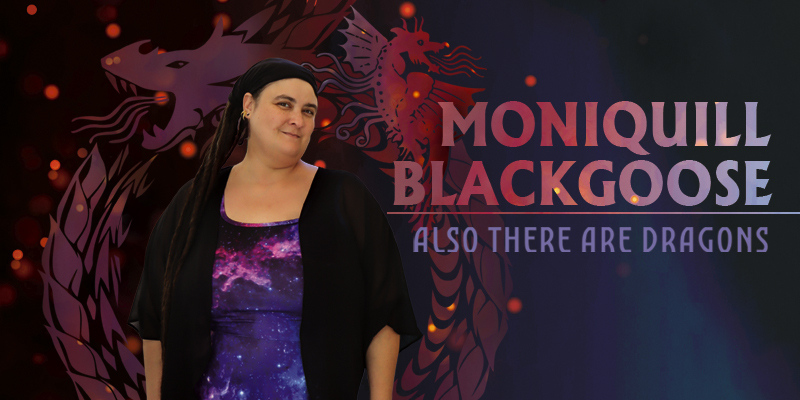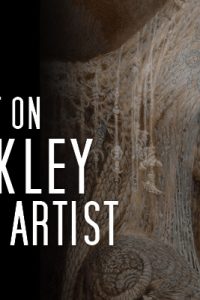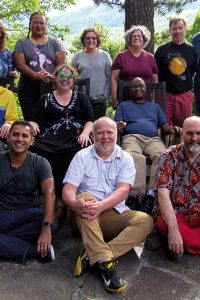Moniquill Blackgoose: Also There Are Dragons
MONIQUILL BLACKGOOSE is an enrolled member of the Seaconke Wampanoag Tribe and a lineal descendant of Ousamequin Massasoit. She writes extensively about depictions of Indigenous and Indigenous-coded characters in SF, and is an active member of steampunk and cosplay communities. She studied cognitive psychology, and worked for several years in a children’s home before becoming a phlebotomist.
Debut novel Cygenic was published in 2020 under the name Monique Poirier. To Shape a Dragon’s Breath appeared in 2023 and launched the Nampeshiweisit trilogy; it won the Andre Norton Award, was a finalist for the Compton Crook Award, and is a finalist for the Lodestar Award. Blackgoose is also currently a finalist for the Astounding Award for Best New Writer. She lives in Rhode Island.
Excerpt from the interview:
“To Shape a Dragon’s Breath is alternate history. The patter line is, it’s about a young woman who leaves her small insular community to go to a dragon-riding school. She is part of a colonized indigenous people, and the school is run by colonizers. It’s about the culture shock of her going among those people for the first time, and also there are dragons.
“There was nothing like this when I was growing up. Indigenous people just weren’t in science fiction and fantasy, and for a long time, my earliest writings didn’t have any indigenous people in them either, because I didn’t think that was allowed. When I wrote terrible Star Trek fan fiction, I could have indigenous people in the future, because Star Trek had done that. The future is diverse. But fantasy was not for me. The most diverse fantasy I saw was Earthsea – it’s got brown people in it. I was also reading Patricia C. Wrede’s Forest Chronicles and the Alanna books by Tamora Pierce. My family were Renaissance Faire-goers, generationally. There’s a photo of me at less than one month old and my mom is in garb and I’m wearing a cloth diaper.
“I was raised on ‘90s fantasy, and I know all the songs. Willow, The Dark Crystal, Labyrinth – all the Jim Henson stuff from that time. If Native Americans were even alluded to, they were either turned into aliens or elves. We were inhuman, extinct, existing only in the past – unless it’s Star Trek. It’s not even true to history! Europe was never like that!
“I wrote the book that I wanted to read as a child, when I wished for a book with an indigenous protagonist. Sometimes they were part of an ensemble cast, but the book was never about the indigenous person – they were there for flavor in that very ‘90s, ‘We’ve checked the boxes, we’ve got one of each type.’ Think of the Captain Planet kids – they’re ticking boxes. Which was better than nothing, maybe. Though not all representation is better than no representation. I’ve written whole essays about how the movie Pocahontas destroyed my life. I was 13 when Pocahontas came out. It didn’t occur to me until I was 11 or 12 that I could be in a fantasy story. Fantasy was its own category to me, and it was a kind of dress-up. You put on your princess dress and you go to the Faire and you feed a goat and sing a lot of songs. And it had nothing to do with lifeway lessons and tribal meetings and everything that was compartmentalized in my life. That’s how it was for my mom – she’s the one who’s from the tribe.
“I didn’t start writing my first indigenous characters until I was in college. I did lots of culture-building and worldbuilding, but I thought Native Americans had to be aliens. I read The Word for the World is Forest for the first time at age 12, and that had a big impact on me, because it has indigenous worldviews in it… but, again, it’s from aliens.
“Native American is one of the identities that gets policed, because there is a history of pretenders. Blood quantum was envisioned to make us disappear. That was a deliberate act, and it hit the East harder than it hit the West, because it hit us first. We got hit really hard between 1600 and 1640 with disease out here. Leptospirosis was the big one; it took out between seven or nine of ten peoples, so we had a full-on apocalypse situation that the Mayflower people rolled up on to. Tisquantum was very solicitous of the Pilgrims because everyone in his village was dead.
“There’s a pronunciation guide in my book, and it’s got a really excellent audiobook. Del Rey went above and beyond to try and make sure everything was pronounced correctly. They had me record reading lists of words. A lot of the time it was weird for me because I am from Rhode Island, and the Algonquin language kind of seeps into the things that are named. There’s the Woonasquatucket River, and I live in the city of Pawtucket, which means ‘where the salt water meets the fresh.’
“The colonizers’ names for places are often bastard names – like in Westport, we’ve got Hassanegk Cove, which is now called Horseneck Beach. It means ‘falls by the sheltered place,’ I think, but the word is ‘hassanegk’ – it just sounds like ‘horse neck’ in English, so. I did some riffing on that because of the way colonizers have renamed things. I did a lot of language research for this, too.
“The book is set in a kind of an alternate 1840s, but the timeline hasn’t progressed the same way. There are no colonizers west of the Mississippi in my world yet. The Roman Empire never existed. This all came because I didn’t want there to be Christianity. Mostly, I didn’t want to invoke trauma about that, because there’s a lot of layers about how Christianity was forced into this country, and people have a lot of different ideas. I didn’t want to alienate people in my tribe who would be alienated if I attacked Christianity as hard as I wanted to attack the colonizers. So now the colonizers are Vikings.
“I don’t know if this came across in the first book, so I’m making it much more clear in the second book, but the colonizers are from the landmass that is Britain, it’s just that that landmass is all Danelaw, because the Danelaw won. It was originally Manx and Gaels and Saxons and all of those people there, and then the Vikings came and imposed their culture, and they got a culture of mélange, which is why they don’t act exactly like Vikings. They are more rigid and puritanical – or, at least, the ones who came to North America are – than real Viking culture would be.
“I did a lot of research on the Great Lakes area dragons: What would dragons that are native to North America be like? There’s not a lot of surviving mythology, but some. There’s also the question of what qualifies as a dragon, because my dragons are different than the trope. Is the underwater panther from Ojibwe mythology a dragon? I don’t know. A horned beast comes from under the water, with a tail made from copper scales that you can pry off if you have cleverness or trickery. I also wanted a creature that made biological sense, where the magic works with laws of physics. The only big conceit I have is if dragons breathe fission – deal with it. I’m not sure how they do that; no one in my world is sure how they do it. There are problems with dissecting dragons because they tend to explode. Right now it’s magic, and it’s been magic for the whole time.
“They’re not people-dragons, they’re animal-dragons. My first draft actually had people-dragons, and I found that it got way too complicated with too many characters, and also brought in really unfortunate slavery implications that I didn’t want to explore. If the dragon could be talked out of pairing with a regular human, it wouldn’t work as a series, because they would just take Anequs’s dragon. The end. I also found it was too easy to have the dyad of Anequs and Kasaqua just talking to each other constantly, and it became hard to write around that. When I thought, ‘What if dragons are just animals?’ it worked much better. The people and the dragons have an empathic bond and can communicate emotions and stuff to each other, but the animal only has animal understanding of the relationship, and you can’t really complicate it. You can convey, ‘Go there.’ That’s an easy command.
Interview design by Francesca Myman
Read the full interview in the August 2024 issue of Locus.
 While you are here, please take a moment to support Locus with a one-time or recurring donation. We rely on reader donations to keep the magazine and site going, and would like to keep the site paywall free, but WE NEED YOUR FINANCIAL SUPPORT to continue quality coverage of the science fiction and fantasy field.
While you are here, please take a moment to support Locus with a one-time or recurring donation. We rely on reader donations to keep the magazine and site going, and would like to keep the site paywall free, but WE NEED YOUR FINANCIAL SUPPORT to continue quality coverage of the science fiction and fantasy field.
©Locus Magazine. Copyrighted material may not be republished without permission of LSFF.








